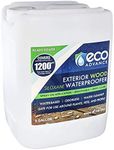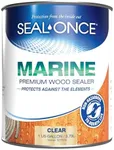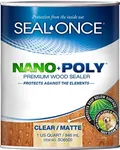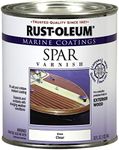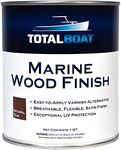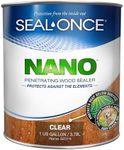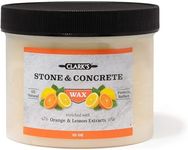Buying Guide for the Best Marine Wood Sealer
Choosing the right marine wood sealer is essential for protecting wood surfaces exposed to water, humidity, and harsh weather conditions. A good sealer will help prevent rot, warping, and damage from UV rays, ensuring your wood stays strong and looks good for years. When picking a sealer, it's important to understand the key features that affect performance and durability, so you can match the product to your specific needs and environment.Type of SealerMarine wood sealers come in different types, such as oil-based, water-based, and epoxy-based. This spec refers to the chemical makeup and how the sealer interacts with the wood. Oil-based sealers penetrate deeply and provide rich protection, making them great for heavy-duty use, but they may take longer to dry and have a stronger odor. Water-based sealers are easier to clean up, dry faster, and are more environmentally friendly, but may not last as long in extreme conditions. Epoxy-based sealers offer a hard, durable finish and are excellent for maximum water resistance, but can be more difficult to apply. To pick the right type, consider how much exposure your wood will have to water and sun, how often you want to reapply, and your comfort with application and cleanup.
UV ProtectionUV protection refers to the sealer's ability to shield wood from the sun's ultraviolet rays, which can cause fading, cracking, and breakdown of the wood fibers. Some sealers include additives that block or absorb UV rays, extending the life and appearance of the wood. Products with high UV protection are best for wood that will be in direct sunlight for long periods, such as decks or boat surfaces. If your wood is mostly shaded or indoors, you may not need as much UV protection. Think about where your wood will be used and how much sun exposure it will get to decide how important this feature is for you.
Water ResistanceWater resistance is a measure of how well the sealer prevents water from penetrating the wood. This is crucial for marine environments, as constant moisture can lead to rot, mold, and swelling. Sealers vary in their level of water resistance, with some forming a surface barrier and others soaking into the wood to repel water from within. For wood that will be submerged or splashed often, look for a sealer with maximum water resistance. For occasional exposure, a moderate level may be enough. Consider the conditions your wood will face to choose the right level of protection.
BreathabilityBreathability describes how well the sealer allows moisture vapor to escape from the wood while still blocking liquid water from getting in. This is important because trapped moisture can cause wood to swell or rot from the inside. Some sealers are designed to be breathable, which is ideal for wood that may get wet but also needs to dry out, such as outdoor furniture or docks. If your wood is in a location where it can dry between wet periods, a breathable sealer is a good choice. For wood that will be constantly wet, breathability may be less important than total water resistance.
Application MethodThe application method refers to how the sealer is applied to the wood—by brush, roller, spray, or even by wiping. Some sealers are thick and require careful brushing, while others are thin and can be sprayed on quickly. The ease of application can affect how well the sealer covers the wood and how much time and effort you need to spend. If you have a large area or complex surfaces, a sprayable or easy-to-apply sealer may be best. For small projects or detailed work, a brush-on sealer gives more control. Think about the size and shape of your project and your comfort with different tools when choosing.
Drying and Curing TimeDrying and curing time is how long it takes for the sealer to become touch-dry and then fully harden or cure. Some sealers dry in a few hours, while others may take a day or more. Curing time is important because the wood should not be exposed to water or heavy use until the sealer is fully set. If you need to use the wood quickly, look for a fast-drying product. If time is not an issue, a slower-curing sealer may offer better long-term protection. Consider your project timeline and how soon you need the wood to be ready for use.
